My Designs
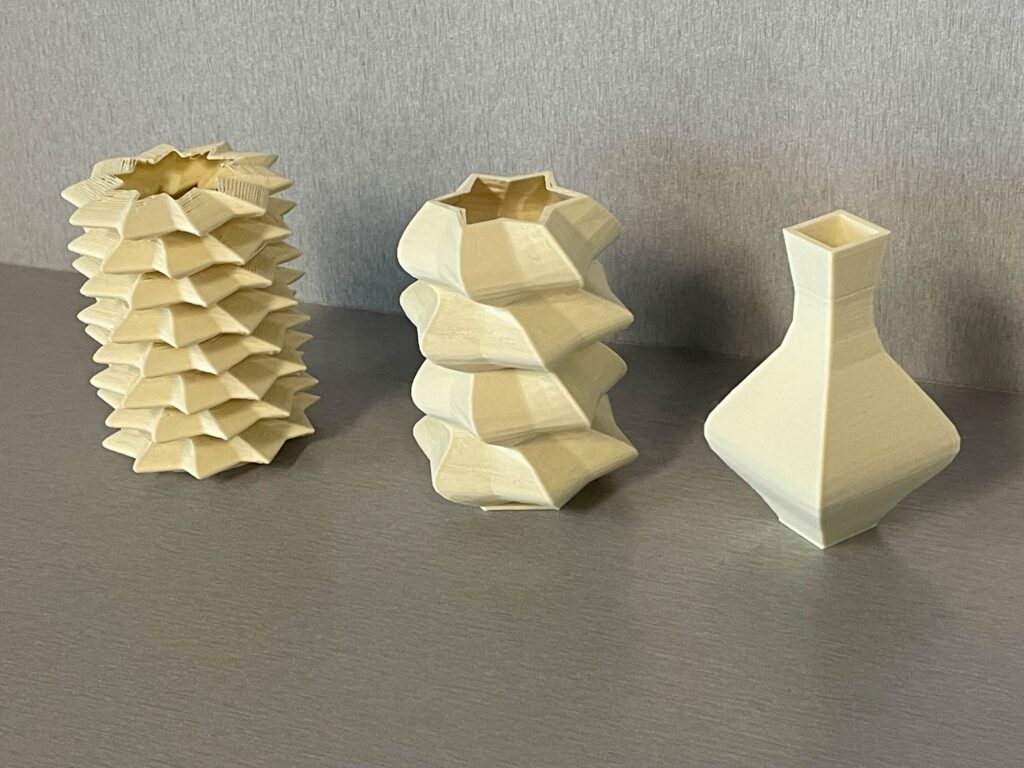
From the outset, I wanted to see how different I could make shapes that were created from the same algorithm. My final algorithm includes parameters spiked or flat sides, twisted layers and repeating structures. To exemplify this I chose a series of forms that get escalating abstract.
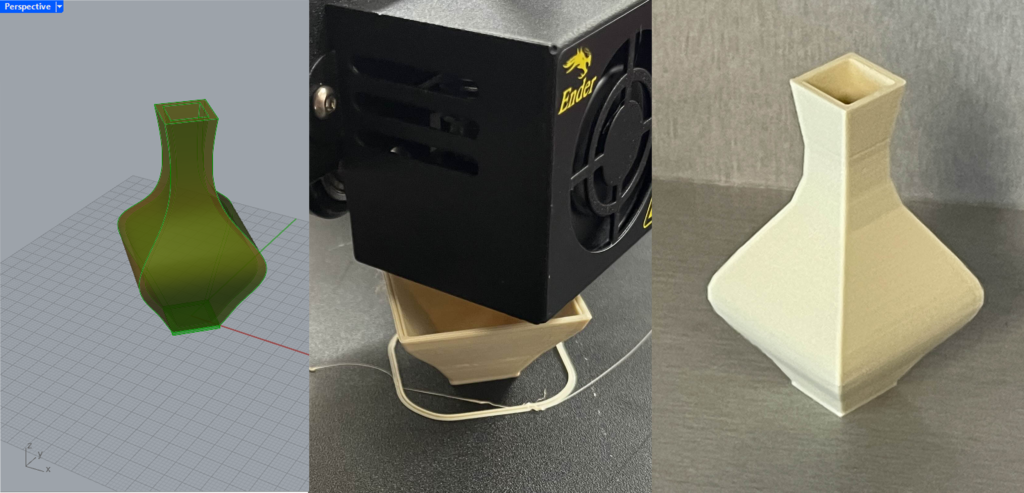
The first has no repeating structures, straight edges, and looks pretty much like a normal vase.
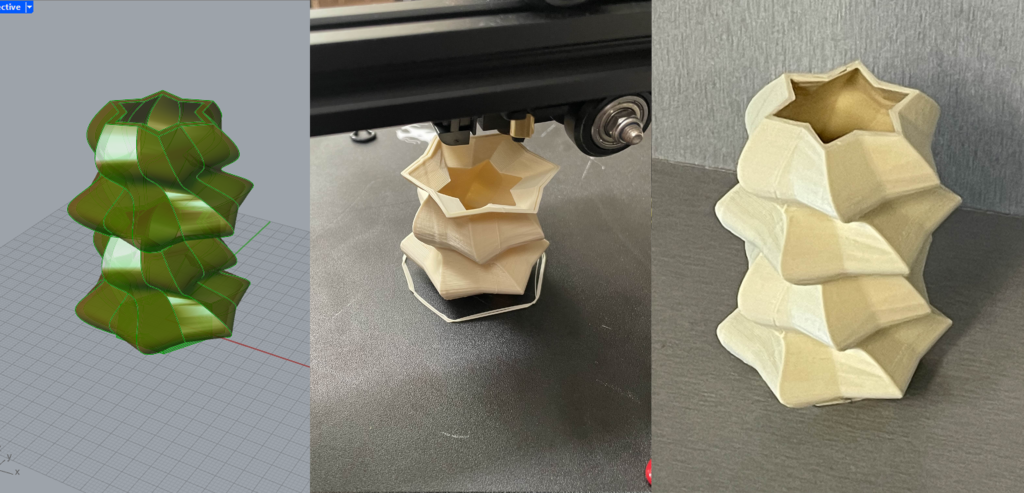
The second I added repeating forms, twisted each layer and added indentation, it looks weirder but still vase shaped.
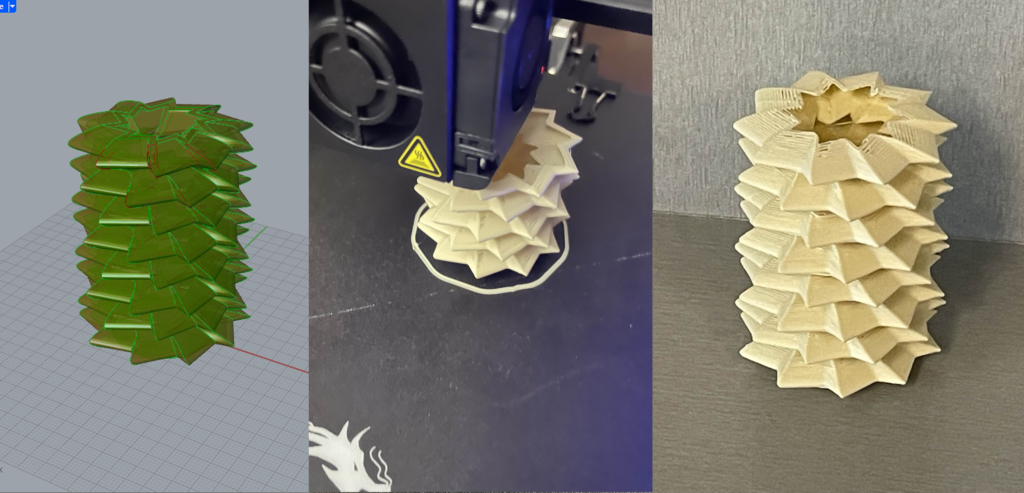
The final one I doubled the number of sides, twisted the spiked sized so they’re asymmetrical, and had it repeat its shape 4 times, the end result of that one looks almost organic to me, kind of like a pine cone. This was the only one I had any real issues with. I don’t think the 3-D printer works very well with the steep slopes and overhangs. It still successfully printed but the texture along the bottom is a lot less consistent than on the other two prints I did.

Reflection on the Parametric Design Process
As someone whose done work with clay and ceramic before there’s a lot to like about 3-D printing and programming. The level of fine detail you can get with a 3-D printer is a lot greater, since computer generated geometry don’t have the same limitations working with your hands do. Programming also lets you add a lot of detail for not that much work. A shape with 4 sides vs 12 isn’t that different to program for. It makes designs scalable and intricate in a way that would be extremely difficult in a more traditional 3-D art form.
There are several major downsides to 3-D printing/programming that do really grind my gears. One is how rigid they are. With clay you can add detail on the fly and adjust as you want. When working with algorithm generated geometry small fluid adjustments are difficult. The lack of physicality with digital modeling is something that makes it difficult to visualize the final form or spot mistakes. When I’m working with clay, I know how the form is coming along because it’s in my hands, I can inspect it dynamically. It’s hard to inspect 3-D prints before they come out because of limited camera functionality and the like 3 levels of conversion from rhino to cura to physical artifacts. So it’s not really until you have the final form printed that you know how it is truly going to look. And that print takes hours.
I tried to leverage these advantages and disadvantages when coming up with my forms. Algorithms do good with lots of small symmetrical changes, so I focused on repeated structures and transformation as the main ways to change the shapes.
Reflection on Creative Agency
I mostly set out with an idea on what I wanted. I wanted my forms to be very math heavy, so I tried to think of all the ways I could have inputs affect the shape. I used series to create repeated patterns that would scale to the size of vessel I wanted. I made it so the twist always snaps to a line of symmetry to keep the repeating pattern motif. I think it gives them all this weird organic look which I really dig. This also informed the series I chose because I wanted to make sure I could show off those ideas in practice. Normally when I do art I tend to do a lot of story stuff with characters and settings. However, since I’m not someone with a lot of experience doing 3-D modeling on computer I decided to see if I work on interesting forms rather than mimicking objects in the real world. Ultimately it all sort of endeared me to the program I was coding for more than the printed product, but I am very happy with both.
My Code
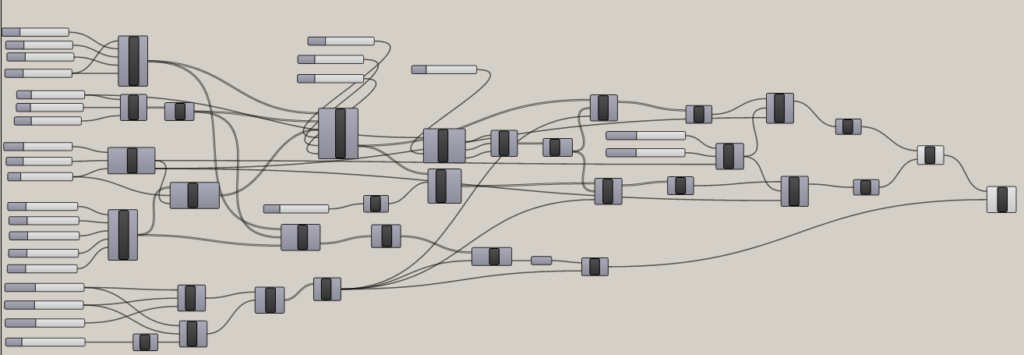
I don’t yet have a good grasp on the scale most people took but I feel like mine got kind of out of hand. I wanted to hard code as little as possible so lost of variables plug into multiple other functions such as the number of repeats of a pattern, automatically scales the height of each instance of the repeating pattern. The other issue is I had lots of frustration with python so I resorted to grasshopper functions often to get what I wanted.
Hi Christopher,
Great Vessels! The shapes remind me of objects that are handmade with clay. Also the color of the filament adds to the organic shape. I never thought of programming as being rigid but you’re right. When programming it follows a sequence of instructions to create your object. Adding that detail during formation does give it that uniqueness. How did you figure out which formulas to use to create the vessels you wanted?
Thanks, I’ve honestly developed a fondness for the off-white filament I got even though I do love some of the more exotic colors other people have. On programming, it is pretty flexible but I’m used to doing art in physical mediums where you can sort of do whatever you want, and in comparison having to follow syntax and use function calls is just more limited. I’m happy to say that regarding the functions, it’s mostly just built off what we learned in class. I added some additions like specific ways to twist the layers and repeating patterns and just sort of explored what outputs I could get.
Hi Christopher,
Your vessels look very creative, especially the last one it looks like a stack of stars! I’m curious how long they took to print. I think as you learn more about Python and explore different functions and techniques, the printing process might start to feel easier. I totally understand how you feel there were times when I thought my code should be working, and just changing a single number determined whether my lofting worked or not. Your code also looks really satisfying, seeing how it takes multiple inputs and slowly merges each function to create the final model.
Thank you, that’s exactly what I was going for. The prints took about 2 hours for the simple vase, 4 hours for the stack of stars, and about 3 for the middle one. In regards to printing, I am just pretty inexperience with python in general and I’m certain things will smooth out as I learn more.
Hi Beau,
I really like how intricate your designs are. I also enjoy how you were able to create them using the same algorithm and the same Grasshopper block, it looks like you took a great deal of time to create your file to create such cool vessels. I like how simple yet refined your fist vessel is it’s simple and elegant. I am really surprised the the other two didn’t have huge fails considering the overhang maybe your settings are just right to keep it all together. Really awesome prints overall!
Thank you, my workload for this project was 90% code because I wanted it to be an all in one system. And honestly after having seen other peoples projects I’m very grateful that I haven’t had the same catastrophic printing errors other people have come across.